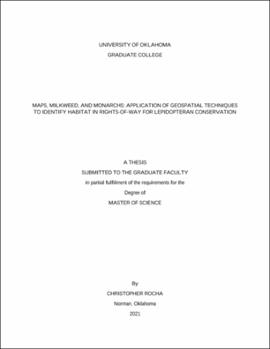| dc.description.abstract | As a signatory of the Nationwide Candidate Conservation Agreement with Assurances for the Monarch Butterfly on Energy and Transportation Lands (CCAA), the Oklahoma Department of Transportation (ODOT) is required to locate and manage habitat for the monarch butterfly. The CCAA requires that 8% of the total land holdings of ODOT to be enrolled for the promotion of, or to facilitate the creation of, quality habitat so the actions may preclude the need to list the monarch (USFWS 2019). However, ODOT currently lacks geospatial data documenting the location of native vegetation on their properties that would foster migrating monarch butterflies. Thus, the objective of this thesis is to fill this gap by identifying and quantifying monarch butterfly and other pollinator habitat using a combination of geospatial and field techniques.
The thesis consists of four chapters. The first chapter is a review of the current literature involving pollinator conservation, and techniques for habitat assessment and monitoring. The subsequent two chapters are research orientated with the objective of improving tools for locating and quantifying nectaring resources and host plants for the monarch butterfly. Both are formatted for submission to the Natural Areas Journal. In chapter two, I analyzed landcover data to locate habitat patches with the potential for containing host and nectaring plants. We found that milkweed (Asclepias spp.), a key resource for monarchs, was present in 32% of our field sites and nearly each site had available nectaring plants. Thus, our findings suggest that ODOTs ROWs have conservation potential for monarchs and may be good candidate lands for enrollment for the CCAA. Chapter three utilized the Rights-of-Ways Habitat Scorecard, developed by the Right of Way working group at the University of Illinois-Chicago, to determine the degree to which habitat quality differs during the spring versus fall migration. Monarchs pass through Oklahoma twice each year, once in the spring as they venture northward from their roosts in Mexico, and again in the fall when they return south. Fieldwork was conducted during the spring and fall migrations of 2020 and 2021 using the pollinator scorecard to evaluate pollinator habitat. The scorecard provides a repeatable method for pollinator habitat elevation across the United States and has been adopted by signatories of the CCAA. Chapter three reports habitat structure and the potential utility (i.e., how the monarch uses the habitat) of existing patches of vegetation and the results of the chi-square test led to the acceptance of the null hypothesis that there is not a significant relationship between habitat quality ratings and seasonality. Chapter three is also formatted for submission to the Natural Areas Journal. Chapter four is an afterword that discusses study limitations and concluding remarks. | en_US |
